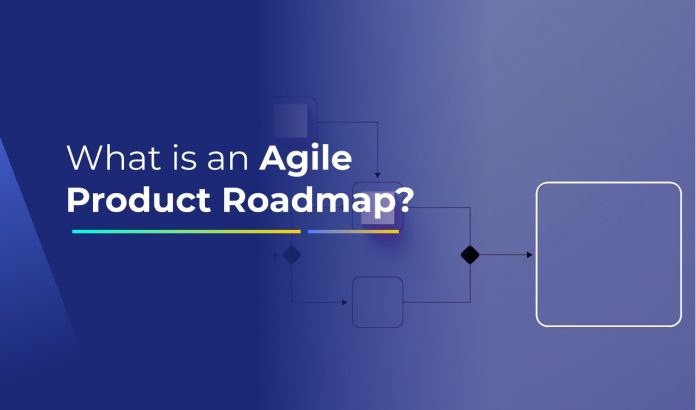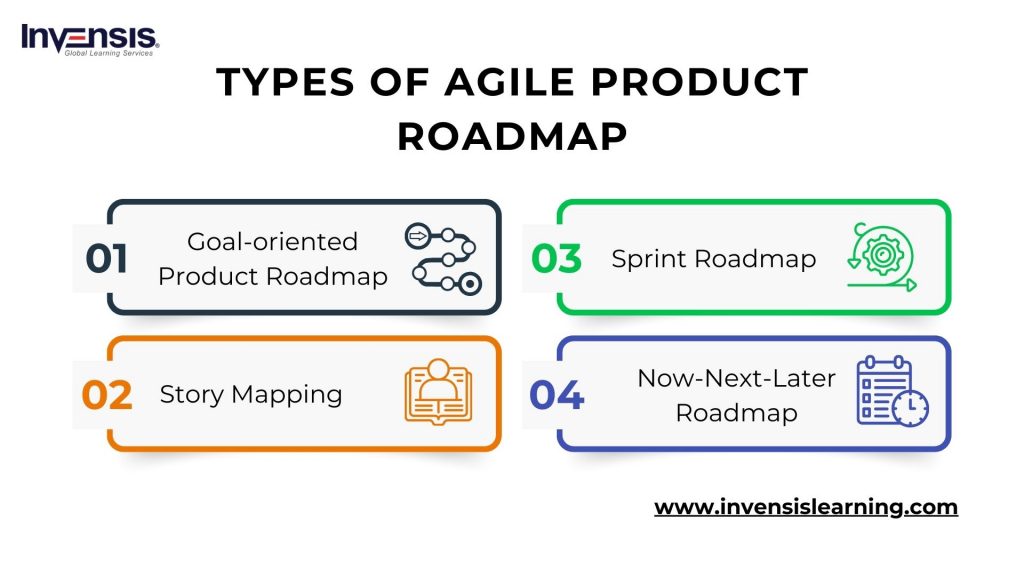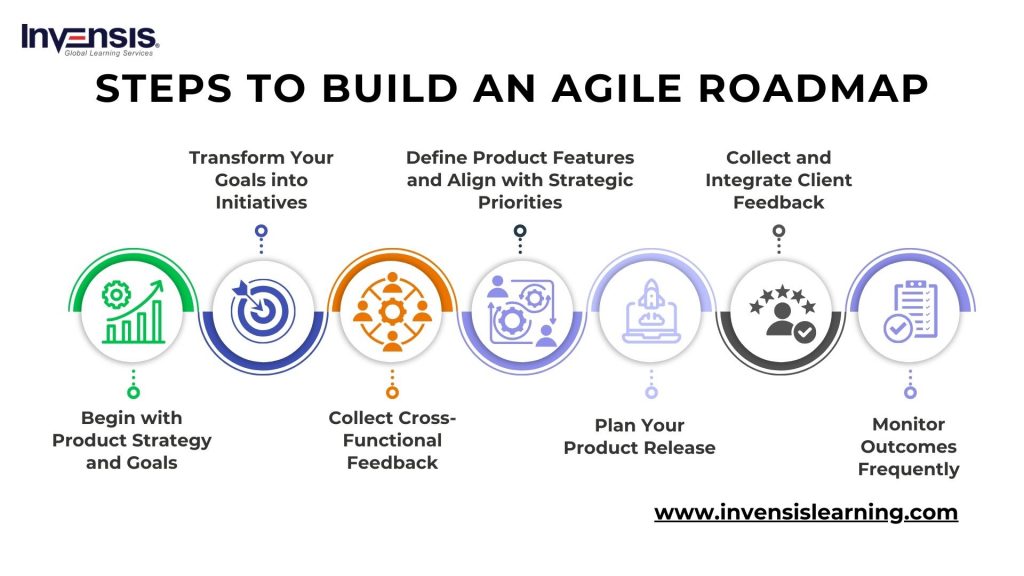
Do you feel overwhelmed by a seemingly endless product backlog and need help with the right path forward? Fear not, resilient product builder! This blog is your roadmap to crafting an effective agile product roadmap, guiding your team through the iterative process. Forget about rigid, outdated plans; here, we embrace the flexibility and adaptability of the agile world.
Discover the secrets to building a roadmap that aligns with your product vision, prioritizes the right features, and keeps up with rapid change.
This blog post explores foundational pillars, master prioritization puzzles, embrace flexibility, and communicate your vision effectively with stakeholders.
Whether you’re a seasoned product manager or a fresher, this blog offers practical tips and actionable advice.
So, let’s collaboratively build an agile product roadmap that truly leads to success!
Table of Contents
- What is a Product Roadmap?
- What is an Agile Product Roadmap?
- Importance of Product Roadmaps in Agile
- Types of Product Roadmaps in Agile
- How to Build an Agile Roadmap?
- Agile Roadmap vs Waterfall Roadmap
- Examples of Product Roadmap
- Conclusion
What is a Product Roadmap?
A product roadmap is a strategic visual tool that outlines the direction and plan for the development and evolution of a product over time. It is a high-level, forward-looking document that communicates the product vision and goals, depicting the key milestones, features, and initiatives planned for future releases.
A product roadmap provides a structured way for teams to align on the product’s trajectory, allowing stakeholders to understand the overall strategy and anticipated developments.
The product roadmap is designed with several ultimate goals in mind, all aimed at guiding a product’s strategic development and success. These goals typically include:
- Ensure everyone understands and agrees on the product’s vision and plans
- Create a strategic plan with key milestones and initiatives
- Prioritize tasks for efficient resource allocation
- Adjust plans based on market changes and user feedback
- Emphasize features that meet customer needs and expectations
Product roadmap aids in coordinating efforts, prioritizing tasks, and facilitating communication among team members and external stakeholders, such as customers, executives, and investors.
The roadmap evolves and adapts based on changing priorities, market conditions, and feedback, making it an essential guide for product managers and teams working towards the successful delivery and improvement of a product.
What is an Agile Product Roadmap?
An Agile Product Roadmap is a dynamic and flexible visual representation outlining the strategic plan for developing and evolving a product in an agile environment. Unlike traditional, static roadmaps, the agile version is adaptable, allowing for changes and iterations based on continuous feedback, shifting priorities, and emerging market conditions.
It typically consists of a timeline with key objectives, features, and user stories prioritized based on value and customer needs.
The Agile Product Roadmap serves as a collaborative tool, fostering communication among cross-functional teams, stakeholders, and leadership to ensure alignment and a shared understanding of the evolving product direction.
Its emphasis is on delivering incremental value, embracing change, and maintaining responsiveness throughout the product development lifecycle.
Importance of Product Roadmaps in Agile
The importance of a Product Roadmap in Agile cannot be overstated, as it plays a pivotal role in guiding and optimizing the product development process. Here are key reasons highlighting its benefits:
- Strategic Alignment: A Product Roadmap in Agile serves as a strategic guide, aligning the product development efforts with the overall business goals and vision.
- Flexibility and Adaptability: Agile methodologies prioritize flexibility and adaptability, and the Product Roadmap reflects this by allowing adjustments based on changing priorities, customer feedback, and market conditions.
- Value-Centric Approach: Unlike traditional roadmaps that might focus on tasks and deadlines, Agile Product Roadmaps are oriented toward delivering value.
- Collaboration and Communication: The Product Roadmap acts as a central communication tool, facilitating collaboration among cross-functional teams and ensuring that all stakeholders are on the same page.
- Risk Mitigation and Learning: Agile Product Roadmaps enhance risk mitigation by employing iterative cycles, feedback loops, and early issue identification, validating assumptions and fostering a more resilient development process.
- Continuous Improvement: The Product Roadmap facilitates learning from each iteration, gathering feedback, and making data-driven decisions, fostering a culture of constant improvement and innovation.
- Customer Satisfaction: By prioritizing features and enhancements based on customer needs and feedback, Agile Product Roadmaps contribute to increased customer satisfaction.
Types of Product Roadmaps in Agile
In Agile development, various product roadmaps serve as visual guides to communicate and plan the evolution of a product. These roadmaps cater to different purposes and timeframes within the Agile framework.
Common types include:
-
Goal-oriented Product Roadmap
A Goal-oriented Product Roadmap is a strategic planning tool that focuses on achieving specific business objectives or goals. Unlike other roadmaps that prioritize features or releases, this type of roadmap centers around the outcomes or results the product team aims to accomplish within a defined timeframe.
Each item on the roadmap is tied directly to a business goal, ensuring that every feature or initiative contributes meaningfully to the product’s overall success.
This roadmap clearly represents how product development aligns with broader organizational objectives, facilitating effective communication and strategic decision-making.
-
Story Mapping
Story Mapping is a visual technique that helps product teams understand and prioritize user stories in a holistic manner. It involves arranging user stories on a horizontal axis to represent the sequence of user activities and on a vertical axis to indicate their priority or importance.
This technique helps teams create a narrative or journey through the product, ensuring that the development work is prioritized based on features and reflects the end-to-end user experience.
Story mapping is a valuable practice in Agile development, fostering collaboration and providing a comprehensive view of the product backlog.
-
Sprint Roadmap
A Sprint Roadmap outlines the planned work for a specific iteration or sprint in an Agile development cycle. It details the user stories, tasks, and goals the team aims to accomplish within the sprint’s duration, typically one to four weeks.
This roadmap ensures that the team has a shared understanding of the work to be undertaken, helping to manage expectations and priorities for the sprint.
It aligns closely with the Agile principle of time-boxed, iterative development, allowing teams to deliver incremental value at the end of each sprint.
-
Now-Next-Later Roadmap
The Now-Next-Later Roadmap is a simple yet effective visual representation of priorities over time. It divides initiatives or features into three categories: “Now” represents the current focus and ongoing work, “Next” outlines upcoming priorities, and “Later” includes items planned for the more distant future.
Now-Next-Later Roadmap provides a snapshot of the product’s trajectory, helping teams and stakeholders understand the immediate, near-term, and long-term priorities.
It is particularly useful for maintaining flexibility and adapting to changing circumstances while clearly viewing the overall product direction.
How to Build an Agile Roadmap?
Building an agile roadmap is like setting up a flexible route plan for your product. Each product team faces unique challenges in terms of stakeholder requests, user requirements, and financial constraints.
As a result, you must understand how to create a product roadmap that will allow you to traverse these hurdles while still providing value to your users and stakeholders.
Here is a step-by-step guide for building an agile roadmap:
-
Begin with Product Strategy and Goals
Initiating the construction of an Agile roadmap starts with a deep dive into the product’s overarching strategy and goals. Understand the long-term vision and objectives that guide the product’s development.
This foundational step ensures that the roadmap is purposefully aligned with the broader organizational mission, providing a cohesive and strategic direction for the development efforts.
-
Transform Your Goals into Initiatives
With a clear understanding of the product’s strategy and goals, the next step is to translate these into actionable initiatives. These initiatives, representing high-level projects or themes, serve as the building blocks for the roadmap.
Transforming goals into initiatives provides a structured framework for organizing and prioritizing the work, ensuring that each initiative contributes meaningfully to the overarching objectives.
-
Collect Cross-Functional Feedback
Foster collaboration among cross-functional teams by actively seeking and collecting feedback. Cross-functional perspectives offer a holistic view, incorporating insights from various stakeholders, including product managers, developers, designers, and marketers.
This collaborative approach ensures that the roadmap addresses diverse requirements, potential challenges, and innovative solutions.
-
Define Product Features and Align with Strategic Priorities
Once initiatives are established, the focus shifts to defining specific product features. Align these features with the strategic priorities identified earlier. This detailed planning phase involves breaking down initiatives into actionable components, ensuring that each feature contributes directly to the overall strategic goals of the product.
-
Plan Your Product Release
Organize the defined features and initiatives into releases, creating a timeline for implementation. Adopt Agile principles such as time-boxed iterations (sprints) to facilitate incremental value delivery. Planning releases involves considering dependencies, prioritizing features, and ensuring that each release contributes to achieving strategic milestones.
-
Collect and Integrate Client Feedback
Engage with clients, end-users, or key stakeholders to gather valuable feedback. Integrating client perspectives into the development process ensures that the product roadmap remains aligned with user needs and expectations.
This iterative feedback loop enhances the user-centric nature of the development approach, contributing to the creation of a product that resonates with its intended audience.
-
Monitor Outcomes Frequently
Regularly monitor and assess the outcomes of each release. This involves analyzing user engagement, assessing product performance, and evaluating the achievement of strategic goals. Frequent outcome monitoring allows for swift adjustments, adaptive planning, and continuous improvement based on real-time data and insights.
By closely tracking outcomes, the Agile roadmap remains dynamic, responsive, and capable of evolving with the changing needs of both users and the business.
Agile Roadmap vs Waterfall Roadmap
The Agile and Waterfall roadmap represents two contrasting projects, and product management approaches. Here’s a comparison between the two:
| Feature | Agile Roadmap | Waterfall Roadmap |
| Iterative Development | Favors iterative development with frequent releases | Adheres to a fixed plan with less room for iteration |
| Flexibility | Emphasizes flexibility and adaptability | Follows a linear, sequential approach with less flexibility |
| Customer-Centric | Prioritizes customer needs and feedback | Customer involvement is typically limited until the final stages |
| Collaboration | Encourages collaboration among cross-functional teams | Collaboration is less emphasized, and tasks follow a predetermined order |
| Continuous Improvement | Promotes a culture of continuous improvement | Focuses on identifying and addressing risks early in the project |
| Change Management | Easily accommodates changes during development | Changes are challenging to implement once the project is underway |
| Phases and Planning | Phases are adaptable, and planning is adjusted based on feedback | Follows a sequential approach with a comprehensive plan defined upfront |
| Risk Management | Manages risks through ongoing adjustments | Aims to identify and mitigate risks early in the project |
In summary, while Agile emphasizes flexibility, customer-centricity, and iterative development, Waterfall follows a more rigid, sequential process with a fixed plan and a comprehensive scope defined upfront.
The choice between Agile and Waterfall depends on the project’s nature, requirements, and the level of flexibility needed during development.
Examples of Product Roadmap
Product roadmaps can take various forms based on the specific needs and goals of a product and its development team. Here are a few examples of product roadmap:
Example 1: Release Plan
A release plan serves as the detailed strategy for executing the chosen tasks and specifies the timeframe for their completion. This plan provides senior executives, stakeholders, cross-functional teams, and customers a broad overview of upcoming product releases.
It is effective for organizing milestones without strict time constraints, particularly when dealing with a fixed scope or regular release schedules, such as a mobile app. This approach allows other teams to anticipate forthcoming features without obligating your team to a specific launch date.
Example 2: Sprint Planning Roadmaps
Product teams that use the agile methodology often utilize a sprint planning roadmap. This roadmap allocates tasks to specific team members and acts as a definitive reference for Agile product management teams.
Typically, a sprint planning roadmap includes:
- The objectives the product team intends to accomplish, ranging from a product release and updates to bug fixes or patches, along with the strategic approach for achieving these goals.
- A detailed breakdown of these objectives into smaller tasks and actionable items.
- User stories that articulate the product or features from the perspective of the ideal user persona.
- A comprehensive product release plan.
- An open feedback mechanism that allows users and stakeholders to provide comments.
While product roadmaps are recognized as dynamic documents evolving with the product, sprint plans are deliberately aspirational, focusing on crafting a forward-looking product vision.
Conclusion
An Agile product roadmap empowers teams to incrementally deliver value to users, remaining adaptable to evolving conditions. In contrast to a waterfall product roadmap, the Agile approach operates on a shorter time scale, allocating resources based on immediate needs.
Collaboration is pivotal when utilizing an Agile product roadmap, requiring engagement with team members such as product designers, developers, stakeholders, and users. This collaborative effort ensures alignment between action items and the overarching vision and business goals of the product.
Ready to master the art of Agile product management and build roadmaps that drive success? Explore Invensis Learning’s Agile Certification courses for comprehensive training. Elevate your skills, confidently navigate product development, and unlock the potential of Agile methodologies. Enroll now to embark on a transformative learning journey!
















